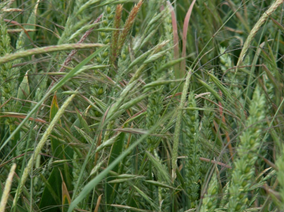Weed Management in All Cereals – August 2020
8 August 2020Pre-harvest and desiccation options for cereals
Due to the difficult growing season, there are crops with secondary tillers and uncontrolled weeds that will benefit from pre-harvest glyphosate. Where there are secondary tillers or there is annual meadow-grass in the base of the crop, a low dose of glyphosate is sufficient because it is particularly effective against annual grasses. Where broad-leaved weeds or couch grass are present the dose should be increased as specified on the product label.
Minimising the dose will lead to reduced residues in the grain. Care is needed because glyphosate is detected in routine residue testing carried out each year on products from shops and supermarkets. Cereal-based products such as bread, breakfast cereal etc. often contain traces of glyphosate – generally well below the MRL. These could originate from imported or home-grown wheat. The results of the Pesticide Residues in Food (PRiF) surveys can be found here.
In order to minimise residues, it is good advice not to routinely treat crops pre-harvest with glyphosate – only pre-harvest spray crops where it will be cost-effective and there will be a benefit from treatment. Use the lowest appropriate dose and adhere to the recommended timings. It is important not to apply before the grain moisture has fallen below 30% as applying earlier increases the risk of residues. It is also important to comply with the harvest interval (7 days in cereals).
There are increasing restrictions by end users on pre-harvest glyphosate so check contracts. Also, be aware when treating pre-harvest of the risk from drift to neighbouring sensitive crops such as seed potatoes.
Winter and spring wheat
Due to difficult conditions last autumn and the prolonged dry spell this spring some crops have some un-controlled weeds and secondary tillers. In these crops there is a proven benefit from pre-harvest glyphosate application – reduced grain moisture and improved combine performance. In weed-free wheat crops that have no secondary tillers, trials by SRUC and in England by NIAB have consistently shown that there is little benefit from pre-harvest glyphosate treatment. In these clean crops it does not increase grain or straw dry matter or improve combine performance.
Glyphosate can be used on feed and milling crops and crops due for distilling – but check with your merchant first. Do not use on seed crops. The wheat must have less than 30% grain moisture – the ‘hard-dough’ stage. This can be confirmed by collecting a representative sample of grain then cutting each grain in half. If 75% of the grains have a dark brown pigment strand in the crease, grain moisture has reached 30%. If all grains have a dark brown pigment strand in the crease, moisture is below 30%.
Glyphosate cannot be used to speed up ripening of crops not yet at the hard dough stage.
Winter and spring barley
It is only worth treating winter barley if it is weedy or has secondary tillers. Most crops are now past the stage for treatment and are being harvested.
In spring barley, trials have shown a small decrease in grain moisture and improved combine performance in the absence of weeds, so if the weather continues changeable there may be a case for treating clean crops. Weedy crops or lodged crops with secondary growth may also benefit from treatment. If the crop is to be sold off farm, check with the end user before treating. Grain must be below 30% moisture before treatment. This can be checked by looking at the peduncle immediately below the ear. When the peduncle, situated at the top of the stalk immediately below the ear starts to lose its green colour and turns brown the moisture level should be ideal for spraying.
Winter and spring oats
Glyphosate can be used as a harvest-aid in milling or feeding oats but check with the end user before treatment, as in some contracts new restrictions have been imposed. Oat grains vary considerably in maturity according to position on the panicle, so make sure that the least mature grains are below 30% moisture content before spraying pre-harvest glyphosate. Due to the later maturity of spring oats compared with other cereals, long-term control of perennial weeds may not be as good where the weeds have started to die back when treated.
Sign up to the FAS newsletter
Receive updates on news, events and publications from Scotland’s Farm Advisory Service

